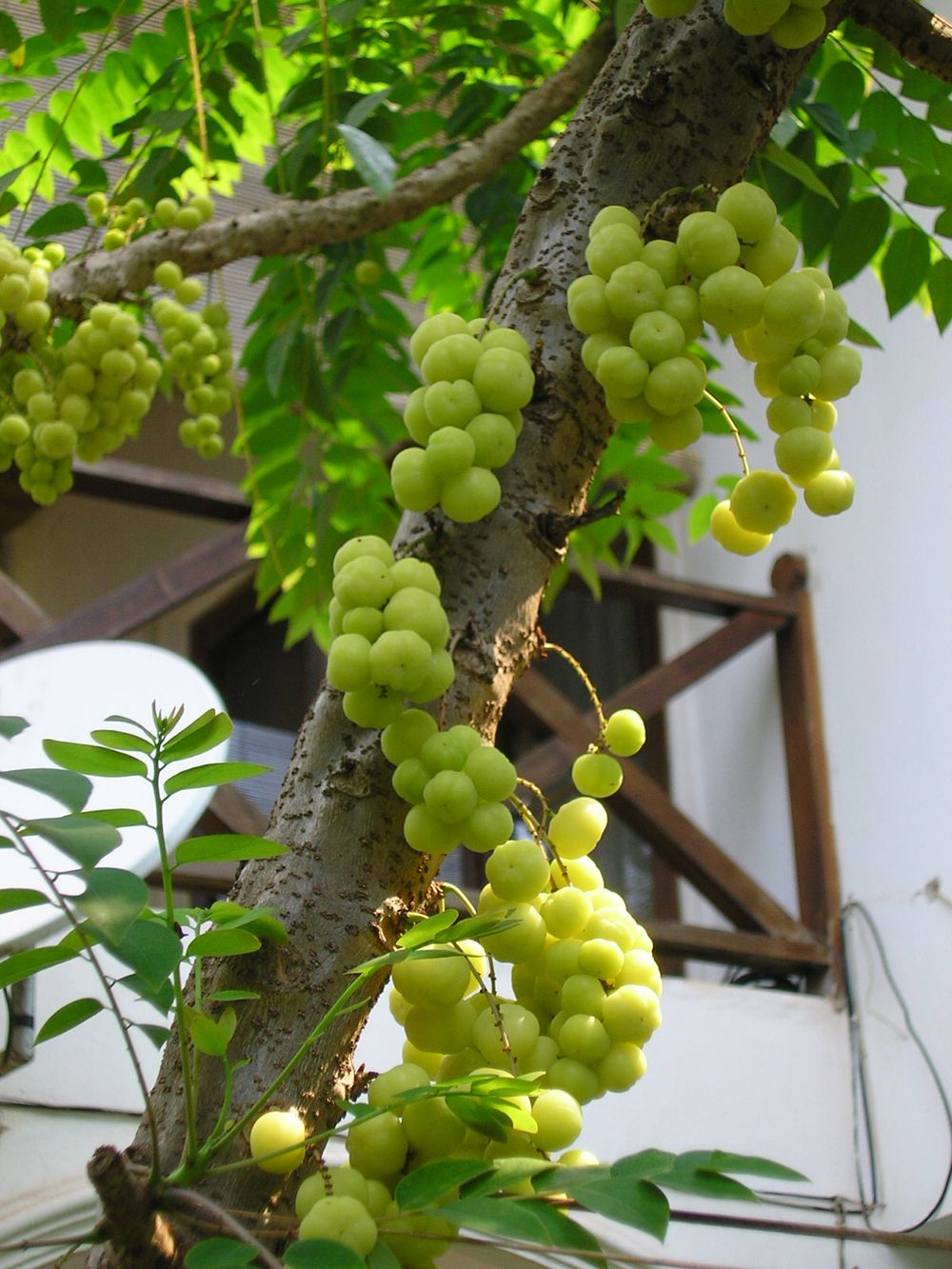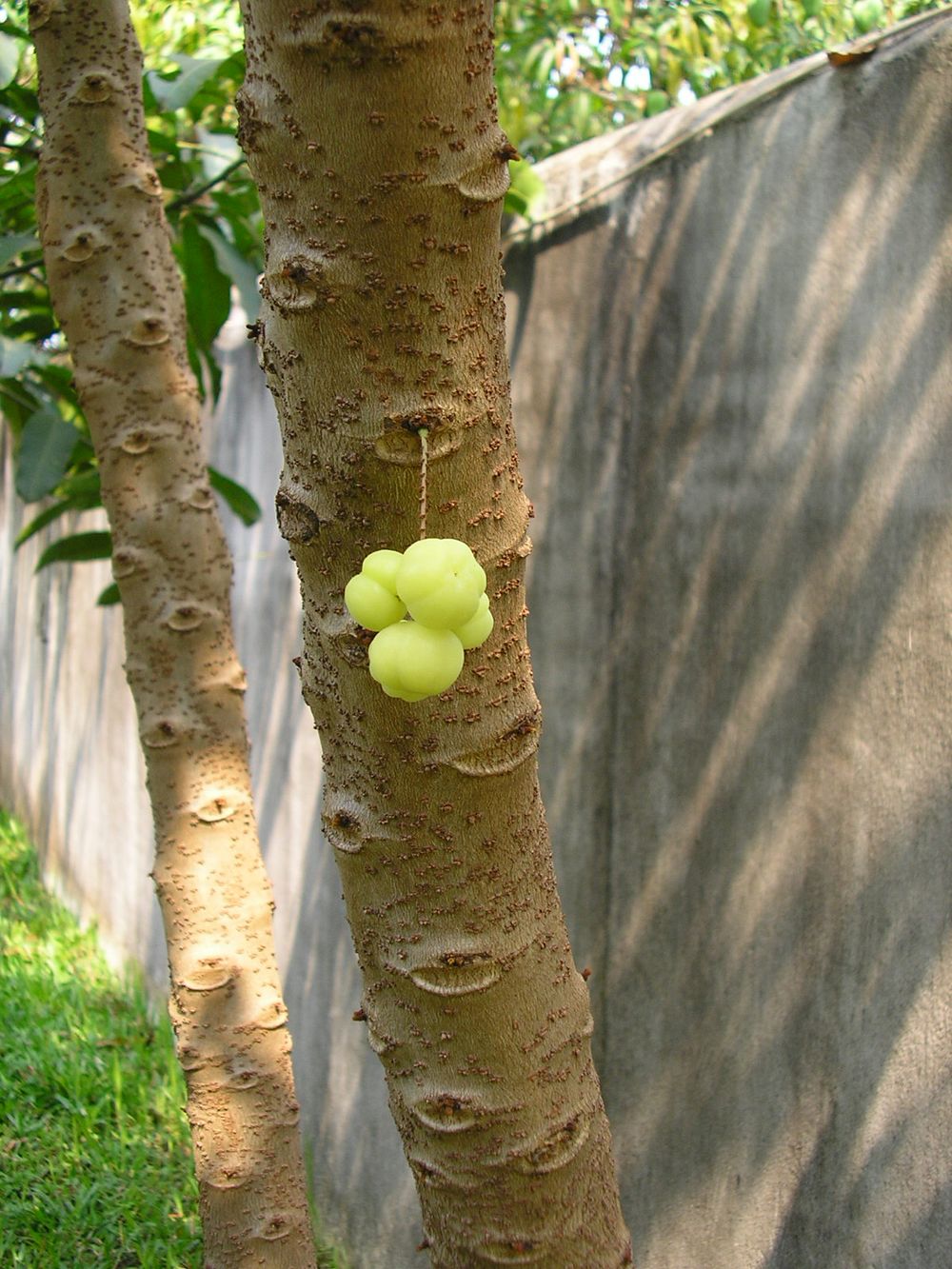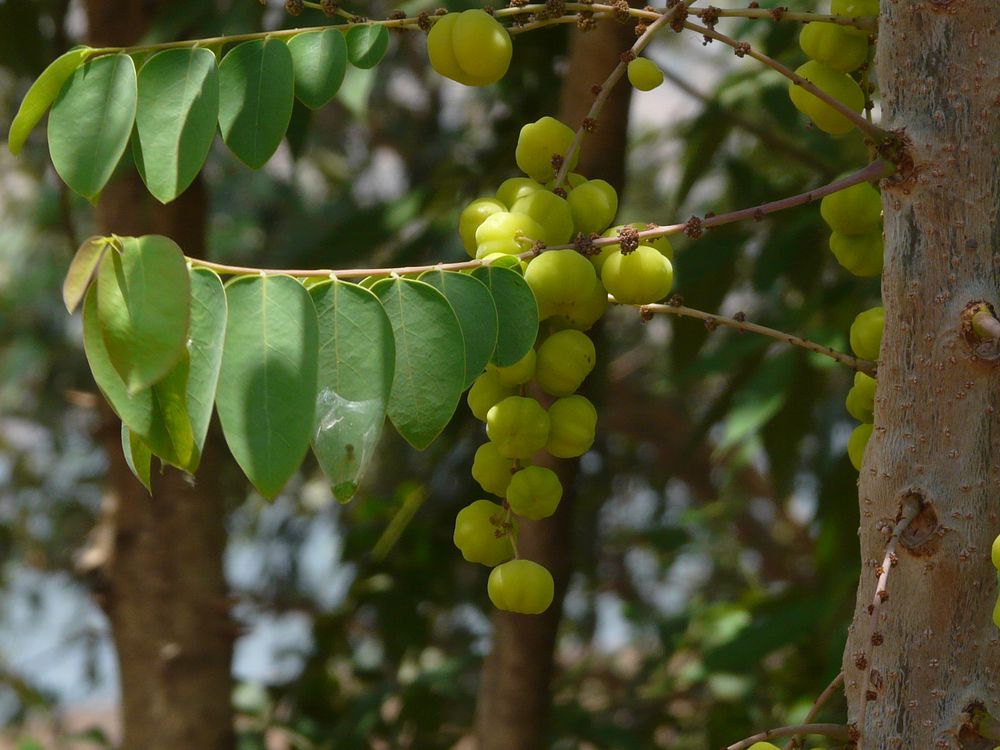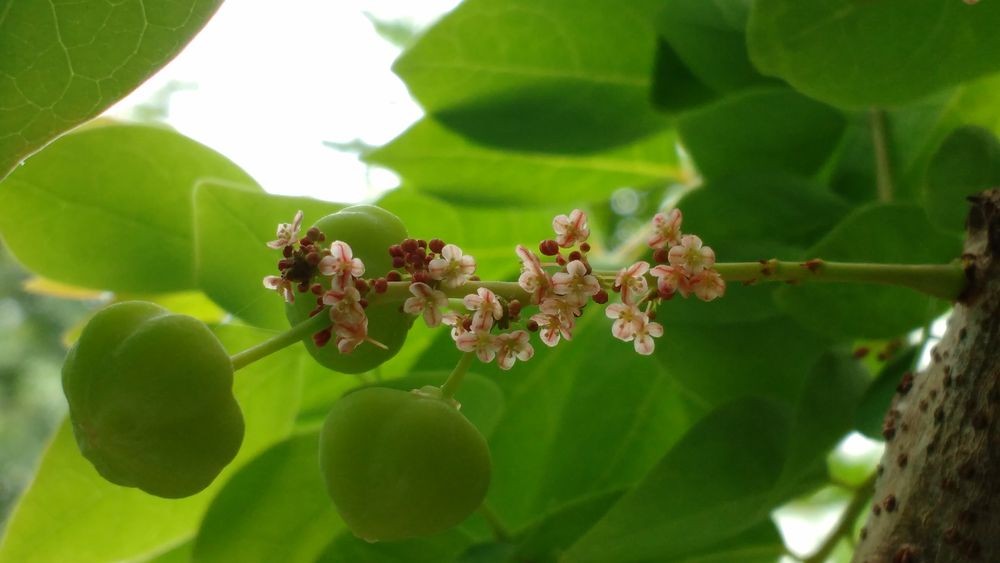The scientific name gives you an immediate indication that the plant is acidic; the French name ‘surelle’ is usually applied to a small, very similar and equally acidic West Indian fruit.
The tree is undoubtedly one of the most widespread in the cities and inhabited areas of Laos because although it is native to Brazil, it has become so acclimatised here that it seems to be at home. It is not very large: its grey bark is marked by the many scars left by the fruits. The leaves are simple, oval, and light green; the pinkish flowers appear at the beginning of the year in the axils of the fallen leaves; the fruits, which appear shortly afterwards, are small drupes which are first green and then yellowish-white and more or less acidic; indeed, there seems to be a very acidic variety while another is almost sweet.
The fruit can be eaten raw, but more often than not it is put in brine (seuam mak nyom) and is offered all year round by street vendors in their mobile shop windows.
The leaves, raw, are added to the dishes to acidify them, which is why som pa (fish confit that has undergone acid fermentation) is sometimes encrusted with small green leaves.
Tone mak nyom has medicinal properties. The milky juice that flows from the various parts of the plant is purgative; a decoction of the otherwise toxic roots is said to relieve headaches; the leaves are said to be effective against various skin diseases when boiled and put in a bath.
In Cambodia, the toxic bark is used to kill dogs with rabies.
However, the fact that there are so many surette plants in and around the houses in Laos is not only due to their easy natural propagation, but also to their semantics: one tone mak nyom (ni nyom meaning “to be faithful”) is planted in one’s garden to be loved!
Le nom scientifique vous donne d’emblée une indication : la plante est acide; le nom français « surelle » s’applique d’ordinaire à un petit fruit des Antilles très ressemblant et tout aussi acide.
L’arbre est, sans doute, l’un des plus répandus dans les villes et les espaces habités au Laos, car bien que natif du Brésil, il s’est acclimaté par ici au point d’y paraître chez lui. Il n’est pas très grand, son écorce grise est marquée par les nombreuses cicatrices laissées par les fruits. Les feuilles sont simples, ovales, vert clair; les fleurs rosâtres naissent, en début d’année, à l’aisselle des feuilles tombées; les fruits, qui apparaissent peu après, sont de petites drupes d’abord vertes puis d’un blanc jaunâtre plus ou moins acides, il semble en effet qu’il y ait une variété très acide alors qu’une autre serait presque sucrée.
Le fruit peut être mangé cru mais, le plus souvent, il est mis en saumure (seuam mak nyom) et est proposé toute l’année par les marchands ambulants dans leur vitrine roulante.
Les feuilles, crues, sont rajoutées aux mets que l’on veut acidifier, c’est pour cette raison que le som pa (confit de poisson ayant subi une fermentation acide) est parfois incrusté de petites feuilles vertes.
Tone mak nyom a des vertus médicinales. Le suc laiteux qui s’écoule des différents parties de la plante est purgatif; une décoction des racines, par ailleurs toxiques, soulagerait les maux de tête; les feuilles bouillies et mises dans un bain seraient efficaces contre différentes maladies de peau.
Au Cambodge l’écorce toxique est utilisée pour tuer les chiens atteints de la rage.
Cependant, si l’on voit tant de pieds de surette autour et dans les habitations au Laos, ce n’est pas dû uniquement à une multiplication naturelle particulièrement facile, mais aussi à la sémantique: on plante tone mak nyom (ni nyom signifiant « être fidèle ») dans son jardin pour être aimé !





The scientific name gives you an immediate indication that the plant is acidic; the French name ‘surelle’ is usually applied to a small, very similar and equally acidic West Indian fruit.
The tree is undoubtedly one of the most widespread in the cities and inhabited areas of Laos because although it is native to Brazil, it has become so acclimatised here that it seems to be at home. It is not very large: its grey bark is marked by the many scars left by the fruits. The leaves are simple, oval, and light green; the pinkish flowers appear at the beginning of the year in the axils of the fallen leaves; the fruits, which appear shortly afterwards, are small drupes which are first green and then yellowish-white and more or less acidic; indeed, there seems to be a very acidic variety while another is almost sweet.
The fruit can be eaten raw, but more often than not it is put in brine (seuam mak nyom) and is offered all year round by street vendors in their mobile shop windows.
The leaves, raw, are added to the dishes to acidify them, which is why som pa (fish confit that has undergone acid fermentation) is sometimes encrusted with small green leaves.
Tone mak nyom has medicinal properties. The milky juice that flows from the various parts of the plant is purgative; a decoction of the otherwise toxic roots is said to relieve headaches; the leaves are said to be effective against various skin diseases when boiled and put in a bath.
In Cambodia, the toxic bark is used to kill dogs with rabies.
However, the fact that there are so many surette plants in and around the houses in Laos is not only due to their easy natural propagation, but also to their semantics: one tone mak nyom (ni nyom meaning “to be faithful”) is planted in one’s garden to be loved!
Le nom scientifique vous donne d’emblée une indication : la plante est acide; le nom français « surelle » s’applique d’ordinaire à un petit fruit des Antilles très ressemblant et tout aussi acide.
L’arbre est, sans doute, l’un des plus répandus dans les villes et les espaces habités au Laos, car bien que natif du Brésil, il s’est acclimaté par ici au point d’y paraître chez lui. Il n’est pas très grand, son écorce grise est marquée par les nombreuses cicatrices laissées par les fruits. Les feuilles sont simples, ovales, vert clair; les fleurs rosâtres naissent, en début d’année, à l’aisselle des feuilles tombées; les fruits, qui apparaissent peu après, sont de petites drupes d’abord vertes puis d’un blanc jaunâtre plus ou moins acides, il semble en effet qu’il y ait une variété très acide alors qu’une autre serait presque sucrée.
Le fruit peut être mangé cru mais, le plus souvent, il est mis en saumure (seuam mak nyom) et est proposé toute l’année par les marchands ambulants dans leur vitrine roulante.
Les feuilles, crues, sont rajoutées aux mets que l’on veut acidifier, c’est pour cette raison que le som pa (confit de poisson ayant subi une fermentation acide) est parfois incrusté de petites feuilles vertes.
Tone mak nyom a des vertus médicinales. Le suc laiteux qui s’écoule des différents parties de la plante est purgatif; une décoction des racines, par ailleurs toxiques, soulagerait les maux de tête; les feuilles bouillies et mises dans un bain seraient efficaces contre différentes maladies de peau.
Au Cambodge l’écorce toxique est utilisée pour tuer les chiens atteints de la rage.
Cependant, si l’on voit tant de pieds de surette autour et dans les habitations au Laos, ce n’est pas dû uniquement à une multiplication naturelle particulièrement facile, mais aussi à la sémantique: on plante tone mak nyom (ni nyom signifiant « être fidèle ») dans son jardin pour être aimé !










The scientific name gives you an immediate indication that the plant is acidic; the French name ‘surelle’ is usually applied to a small, very similar and equally acidic West Indian fruit.
The tree is undoubtedly one of the most widespread in the cities and inhabited areas of Laos because although it is native to Brazil, it has become so acclimatised here that it seems to be at home. It is not very large: its grey bark is marked by the many scars left by the fruits. The leaves are simple, oval, and light green; the pinkish flowers appear at the beginning of the year in the axils of the fallen leaves; the fruits, which appear shortly afterwards, are small drupes which are first green and then yellowish-white and more or less acidic; indeed, there seems to be a very acidic variety while another is almost sweet.
The fruit can be eaten raw, but more often than not it is put in brine (seuam mak nyom) and is offered all year round by street vendors in their mobile shop windows.
The leaves, raw, are added to the dishes to acidify them, which is why som pa (fish confit that has undergone acid fermentation) is sometimes encrusted with small green leaves.
Tone mak nyom has medicinal properties. The milky juice that flows from the various parts of the plant is purgative; a decoction of the otherwise toxic roots is said to relieve headaches; the leaves are said to be effective against various skin diseases when boiled and put in a bath.
In Cambodia, the toxic bark is used to kill dogs with rabies.
However, the fact that there are so many surette plants in and around the houses in Laos is not only due to their easy natural propagation, but also to their semantics: one tone mak nyom (ni nyom meaning “to be faithful”) is planted in one’s garden to be loved!
Le nom scientifique vous donne d’emblée une indication : la plante est acide; le nom français « surelle » s’applique d’ordinaire à un petit fruit des Antilles très ressemblant et tout aussi acide.
L’arbre est, sans doute, l’un des plus répandus dans les villes et les espaces habités au Laos, car bien que natif du Brésil, il s’est acclimaté par ici au point d’y paraître chez lui. Il n’est pas très grand, son écorce grise est marquée par les nombreuses cicatrices laissées par les fruits. Les feuilles sont simples, ovales, vert clair; les fleurs rosâtres naissent, en début d’année, à l’aisselle des feuilles tombées; les fruits, qui apparaissent peu après, sont de petites drupes d’abord vertes puis d’un blanc jaunâtre plus ou moins acides, il semble en effet qu’il y ait une variété très acide alors qu’une autre serait presque sucrée.
Le fruit peut être mangé cru mais, le plus souvent, il est mis en saumure (seuam mak nyom) et est proposé toute l’année par les marchands ambulants dans leur vitrine roulante.
Les feuilles, crues, sont rajoutées aux mets que l’on veut acidifier, c’est pour cette raison que le som pa (confit de poisson ayant subi une fermentation acide) est parfois incrusté de petites feuilles vertes.
Tone mak nyom a des vertus médicinales. Le suc laiteux qui s’écoule des différents parties de la plante est purgatif; une décoction des racines, par ailleurs toxiques, soulagerait les maux de tête; les feuilles bouillies et mises dans un bain seraient efficaces contre différentes maladies de peau.
Au Cambodge l’écorce toxique est utilisée pour tuer les chiens atteints de la rage.
Cependant, si l’on voit tant de pieds de surette autour et dans les habitations au Laos, ce n’est pas dû uniquement à une multiplication naturelle particulièrement facile, mais aussi à la sémantique: on plante tone mak nyom (ni nyom signifiant « être fidèle ») dans son jardin pour être aimé !


